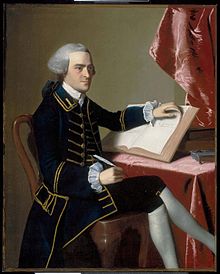John Hancock
![]()
This article is ambiguous. For other meanings, see John Hancock (disambiguation).
![]()
This article or section is still missing the following important information:
Oops, nothing to live for after the revolution? See for example Shay's Rebellion
Help Wikipedia by researching and adding them.
John Hancock (b. 12 January 1736jul. / 23 January 1737greg. in Braintree, Province of Massachusetts Bay; † 8 October 1793 in Quincy, Massachusetts) was a British-American merchant and one of the political leaders of the Thirteen Colonies in the American War of Independence against the British mother country. He was the third president of the Continental Congress and a co-signer of the Declaration of Independence.
Live
Hancock inherited a Boston trading house from his uncle and increased his fortune. This led to a confrontation with British customs officials, who seized his sloop. In 1762, while on a business trip in Quebec, he was admitted as a Mason in Marchants Lodge No. 277. In 1773 he was one of the organizers of the Boston Tea Party and was a member of the Sons of Liberty.
John Hancock held the office of President of the Continental Congress from May 24, 1775 to October 30, 1777. On June 19, 1775, Hancock appointed George Washington commander-in-chief of the Continental Army. In 1780 he was among the first members of the American Academy of Arts and Sciences. From 1780 to 1785 and from 1787 to 1793, Hancock was governor of Massachusetts. He died during his second term and was buried at the Old Granary Burying Ground in Boston.
In his capacity as President of the Continental Congress, John Hancock was the first signer of the Declaration of Independence on July 4, 1776. The distinctive and with 13 cm - compared to all other signatories - extremely large signature on the document has made the name John Hancock in American English synonymous with signature - analogous to the German Friedrich Wilhelm. This is evident, for example, in the typical request "Please, put your John Hancock here! " ("Sign here, please!").
Honors and "Afterlife"
Numerous streets and buildings in the USA are named after John Hancock, including the John Hancock Center in Chicago and the John Hancock Tower in Boston. The U.S. Navy has named several ships after him, including the USS Hancock (CV-19), an Essex-class aircraft carrier, and the Spruance-class destroyer USS John Hancock (DD-981), which bore Hancock's signature on its stern as a special feature.
The eponymous insurance company "John Hancock" named itself after him because dedication and integrity were associated with his names.
· 
John Hancock Center in Chicago
· 
John Hancock Tower in Boston
Questions and Answers
Q: Who was John Hancock?
A: John Hancock was an early American patriot, a leader in the American Revolutionary War, and an American statesman. He was the first man to sign America's Declaration of Independence. In modern America, "John Hancock" is a synonym for signature.
Q: When and where was he born?
A: John Hancock was born on January 12, 1737 in Braintree (now Quincy), Massachusetts.
Q: What happened when British officials seized his ship, the Liberty?
A: The Liberty carried a shipment of wine and British officials accused him of smuggling. This incident led to Boston patriots rioting and he being acquitted.
Q: What important jobs did he have in Colonial America and the early United States of America?
A: He served as president of the Massachusetts Provincial Congress in 1774 and 1775, president of the Continental Congress in 1774 and 1775, led the convention that adopted the Massachusetts Constitution in 1780, and was first Governor of Massachusetts serving nine terms.
Q: Did he ever try to lead the Continental Army?
A: Yes, he wanted to lead it but George Washington got the job instead. With 5,000 troops he tried to free Rhode Island from Britain but wasn't successful.
Q: How did he support American independence?
A: He used his money to support American independence. The British thought him a very dangerous man due to this support.
Q: How did John Hancock die?
A:He died from gout complications on October 8th ,1793
Search within the encyclopedia

